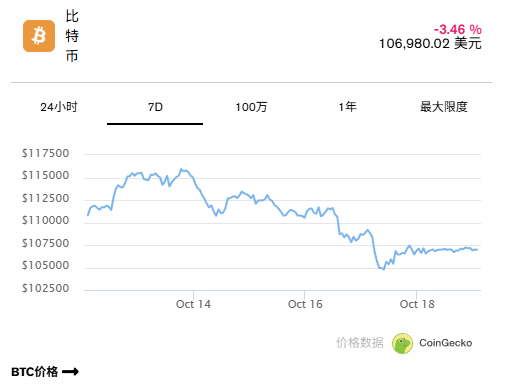Written by: decrypt
Compiled by: Blockchain in Plain Language
The Mt. Gox hack in 2011 caused the most severe crash in Bitcoin history, with prices plummeting by 99.9% after hackers sold stolen BTC at low prices.
The major crashes stemmed from China's ban, COVID-19 panic, and the collapse of cryptocurrency platforms like Celsius and FTX.
Donald Trump's threat of tariffs on China in October 2025 triggered a 13% drop and $19 billion in liquidated positions—but it did not make this list.
The cryptocurrency market crash on October 10, 2025, liquidated an unprecedented $19 billion worth of leveraged Bitcoin and other cryptocurrency positions. However, this was far from the largest percentage drop in BTC price on record.
From Mt. Gox's "penny trade" to the shock of the FTX collapse, here are the hard landings of Bitcoin prices and the factors behind them.
1. Mt. Gox Flash Crash (June 2011)
This was the most severe incident. After a hacker stole hundreds of thousands of BTC and sold them for a penny, the price of Bitcoin on Mt. Gox plummeted by about 99.9%. At the time, Mt. Gox handled about 90% of all Bitcoin transactions. Due to Mt. Gox's dominance in Bitcoin trading, the internal collapse of the platform nearly wiped out the entire market's value in a short time.
(According to the Guinness World Records, Mt. Gox was the leading Bitcoin exchange at the time, but it was not the first. The first was BitcoinMarket.)

The Mt. Gox hack actually occurred on June 15, 2011, but it was not disclosed until days later. An auditor's account at Mt. Gox was compromised and used to steal 740,000 BTC from customers and 100,000 BTC from the company itself. As the attackers sold these BTC, the price plummeted to just a few cents.
At that time, this batch of Bitcoin was worth about $460,000. At current prices, 840,000 BTC would be worth nearly $94 billion. This is equivalent to the total BTC reserves of Michael Saylor's Strategy, Bitcoin mining company MARA Holdings, Jack Mallers' XXI, Japanese Bitcoin giant Metaplanet, Adam Back's Bitcoin Standard Treasury Co., and newly listed Bullish combined.

2. Mt. Gox Circuit Breaker (April 2013)
Due to what was later termed a distributed denial-of-service (DDoS) attack on Mt. Gox, Bitcoin fell from $265 to $150 in April 2013, a drop of about 43%. DDoS attacks overwhelm a target URL with external requests, making it inaccessible to legitimate users.
This attack meant that trading on Mt. Gox was continuously frozen amid record traffic, triggering a sharp sell-off.
At the time, Mt. Gox stated that such attacks had become very common. "Attackers wait until the price of Bitcoin reaches a certain value, then sell, destabilizing the trading platform, waiting for everyone to panic sell their Bitcoin, waiting for the price to drop to a certain amount, then stop the attack and start buying as much as possible. As we saw in the past few days, repeating this two or three times, they can profit," the platform wrote at the time, according to a now-deleted Facebook post cited by TechCrunch.
3. China Ban Panic (December 2013)
In December 2013, the People's Bank of China explicitly stated that it did not want banks to engage with Bitcoin, as it was not backed by any national or central authority.
Bitcoin was experiencing a rapid rise at the time. By the end of November, Bitcoin had first climbed above $1,000. By December 5, Bitcoin had risen to over $1,200. But two days later, as investors digested the impact of the Chinese banking ban, the price dropped by about 50%, falling below $600.
Around this time, former Federal Reserve Chairman Alan Greenspan began publicly mocking Bitcoin as "a bubble."
"You really have to stretch your imagination to infer what the intrinsic value of Bitcoin is," he said in an interview with Bloomberg. "I haven't done it. Maybe others can."
4. Another China Ban (September 2017)
In early September 2017, China announced that initial coin offerings (ICOs) were illegal, labeling them as an "illegal" form of fundraising.
Initially, the market was indifferent, viewing the move as a crackdown on tokens rather than Bitcoin itself. But a week later, when reports emerged that Beijing would also force domestic trading platforms to shut down, panic began to spread. As BTCC, Huobi, and OKCoin confirmed their closures on September 14 and 15, Bitcoin plummeted by about 25% in two days—from around $4,400 to $3,300.
This sell-off marked the end of China's dominance in crypto trading, with global liquidity shifting to Japan and South Korea.
5. Leverage Liquidation (December 2017)
By the end of 2017, Bitcoin had been soaring, nearing the $20,000 mark for the first time.
Subsequently, the introduction of Bitcoin futures on regulated trading platforms, along with overheated market sentiment, led to a drop that saw BTC fall from about $16,500 on December 22 to about $11,000 the next day. In 24 hours, Bitcoin lost about one-third of its value, or 33.3%, marking the beginning of a year-long bear market.
The Chicago Board Options Exchange (CBOE) and the Chicago Mercantile Exchange (CME) had just launched cash-settled Bitcoin futures contracts.
This is not to say that there were no crypto-native Bitcoin derivatives trading platforms at the time—Deribit, BitMEX, and Kraken were all active. But crypto-native companies were either overseas or unregulated at that time. Wall Street "suits" preferred to use venues that had already been licensed by the Commodity Futures Trading Commission.
Months later, the San Francisco Federal Reserve Bank released a report attributing the December crash to the introduction of futures.
The bank wrote, "The rapid rise in prices following the launch of futures and the subsequent decline does not appear to be a coincidence." "Rather, it is consistent with the trading behavior typically associated with the introduction of asset futures markets."
6. COVID: "Black Thursday" (March 12, 2020)
The outbreak of the COVID-19 pandemic sent investors into a panic and led to one of Bitcoin's largest crashes.
The BTC crash occurred the day after the World Health Organization officially declared a global pandemic. The following day, BTC started just below $8,000 and then plummeted to about $4,850, losing nearly half its value.
Over $1 billion in leveraged long positions were liquidated that day, forcing BitMEX, Binance, and other trading platforms into a chain reaction of sell-offs.
This crash was severe, earning the nickname "Black Thursday." But the good news is that following this crash was a bull market year, during which BTC broke all imaginable records.

7. China Crackdown: "Black Wednesday" (May 19, 2021)
In mid-May, Tesla suddenly canceled its plan to accept Bitcoin as payment for its electric vehicles, unsettling BTC investors. The market showed some recovery, but traders only got a brief respite.
A week later, the People's Bank of China cracked down on Chinese Bitcoin miners, leading to a free fall in prices and a collapse in BTC hash rate (the mining power that helps secure the network).
Within hours of Beijing reiterating its ban on crypto trading, panic selling and chain liquidations wiped out about $8 billion from leveraged positions.
This crash was severe, earning the nickname "Black Wednesday." In about 12 hours, Bitcoin fell from around $43,000 to about $30,000, a drop of about 30%. The losses did not stop there. By June 22, 2021, Bitcoin fell below $30,000 for the first time in six months.
8. Celsius Freezing and Contagion (June 13, 2022)
The crypto lending platform Celsius froze withdrawals and trading on June 12, citing "extreme market conditions." This move came just two months after the collapse of TerraUSD, raising concerns about a broader liquidity crisis.
TerraUSD, an algorithmic stablecoin from Terraform Labs, had collapsed just two months prior. The token was designed to maintain a 1:1 peg with the dollar but fell to 13 cents during the crash.
Thus, when Celsius froze withdrawals, claiming it was to "stabilize liquidity," investors panicked. At its peak, Celsius offered high yields on customers' crypto deposits. But when customers were suddenly cut off from their funds on the platform, Bitcoin was hit hardest.
On the day the announcement was made, Bitcoin started at around $26,000 and then dropped 15% to below $22,000.
9. FTX Shakes Before Bankruptcy (November 8-9, 2022)
Panic swept the market when reports emerged that Sam Bankman-Fried's FTX trading platform was facing a liquidity crisis.
On November 8, as FTX suspended withdrawals, Bitcoin fell over 17% in 24 hours, from about $20,500 to $16,900, briefly touching $15,600.
Within days, FTX filed for bankruptcy—this crash rippled through the entire crypto industry, with effects felt for the next two years.
免责声明:本文章仅代表作者个人观点,不代表本平台的立场和观点。本文章仅供信息分享,不构成对任何人的任何投资建议。用户与作者之间的任何争议,与本平台无关。如网页中刊载的文章或图片涉及侵权,请提供相关的权利证明和身份证明发送邮件到support@aicoin.com,本平台相关工作人员将会进行核查。



